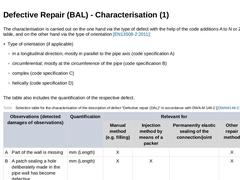
|
The characterisation is carried out on the one hand via the type of defect with the help of the code additions A to N or Z listed in the table, and on the other hand via the type of orientation [EN13508-2:2011]: |
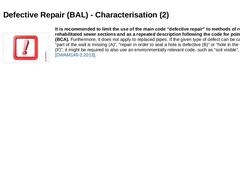
|
Important: It is recommended to limit the use of the main code “defective repair” to methods of repair in rehabilitated sewer sections and as a repeated description following the code for point repair (BCA). Furthermore, it does not apply to replaced pipes. If the given type of defect can be categorised as “part of the wall is missing (A)”, "repair in order to seal a hole is defective (B)” or “hole in the repair material (F)”, it might be required … |
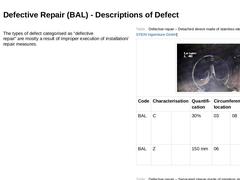
|
The types of defect categorised as “defective
repair” are mostly a result of improper execution of installation/repair measures. (Table: Defective repair – Detached sleeve made of stainless steel) (Table: Defective repair – Separated sleeve made of stainless steel) |
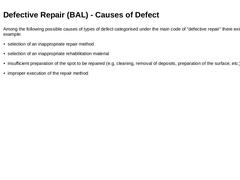
|
Among the following possible causes of types of defect categorised under the main code of “defective repair” there exist, for example: -
selection of an inappropriate repair method
-
selection of an inappropriate rehabilitation material
-
insufficient preparation of the spot to be repaired (e.g. cleaning, removal of deposits, preparation of the surface, etc.)
-
improper execution of the repair method
|
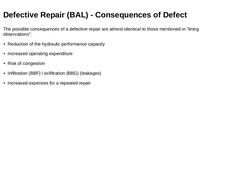
|
The possible consequences of a defective repair are almost identical to those mentioned in “lining
observations”: -
Reduction of the hydraulic performance capacity
-
Increased operating expenditure
-
Risk of congestion
-
Infiltration (BBF) / exfiltration (BBG) (leakages)
-
Increased expenses for a repeated repair
|
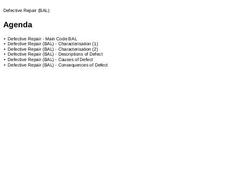
|
|
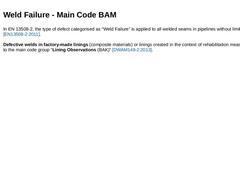
|
In EN 13508-2, the type of defect categorised as “Weld Failure” is applied to all welded seams in pipelines without limitations [EN13508-2:2011].
Defective welds in factory-made linings (composite materials) or linings created in the context of rehabilitation measures belong to the main code group “Lining Observations (BAK)” [DWAM149-2:2013]. |
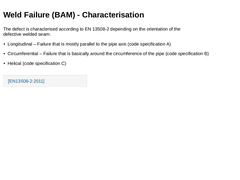
|
The defect is characterised according to EN 13508-2 depending on the orientation of the
defective welded seam: -
Longitudinal – Failure that is mostly parallel to the pipe axis (code specification A)
-
Circumferential – Failure that is basically around the circumference of the pipe (code specification B)
-
Helical (code specification C)
|
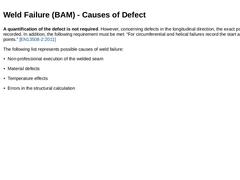
|
A quantification of the defect is not required. However, concerning defects in the longitudinal direction, the exact position must be recorded. In addition, the following requirement must be met: “For circumferential and helical failures record the start and finish points.” [EN13508-2:2011] The following list represents possible causes of weld failure: |
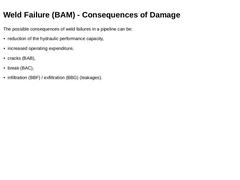
|
The possible consequences of weld failures in a pipeline can be: -
reduction of the hydraulic performance capacity,
-
increased operating expenditure,
-
cracks (BAB),
-
break (BAC),
-
infiltration (BBF) / exfiltration (BBG) (leakages).
|
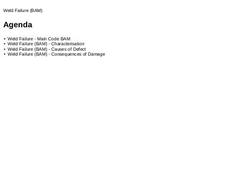
|
|
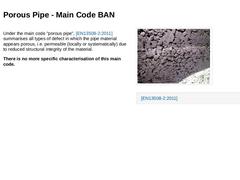
|
Under the main code "porous pipe", [EN13508-2:2011] summarises all types of defect in which the pipe material appears porous, i.e. permeable (locally or systematically) due to reduced structural integrity of the material. There is no more specific characterisation of this main code. (Image: Surface damage - Honeycomb (mortar fails to fill the spaces between coarse aggregates); porous pipe wall (Main code: Porous pipe (BAN))) |
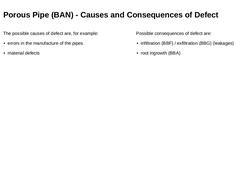
|
The possible causes of defect are, for example: Possible consequences of defect are: |
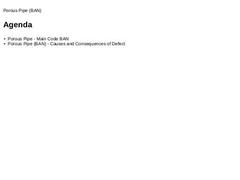
|
|
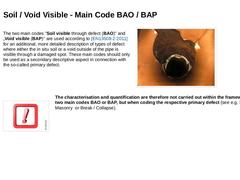
|
The two main codes "Soil visible through defect (BAO)" and „Void visible (BAP)" are used according to [EN13508-2:2011] for an additional, more detailed description of types of defect where either the in situ soil or a void outside of the pipe is visible through a damaged spot. These main codes should only be used as a secondary descriptive aspect in connection with the so-called primary defect. (Image: Pipe break – Missing parts in the pipe wall) Important: |
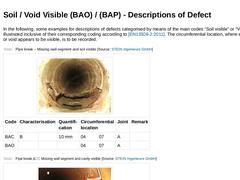
|
In the following, some examples for descriptions of defects categorised by means of the main codes “Soil visible” or “Void visible” are illustrated inclusive of their corresponding coding according to [EN13508-2:2011]. The circumferential location, where either the soil or void appears to be visible, is to be recorded. (Table: Pipe break – Missing wall segment and soil visible) (Table: Pipe break – Missing wall segment and cavity visible) |
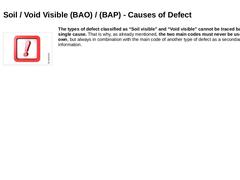
|
Important: The types of defect classified as “Soil visible” and “Void visible” cannot be traced back to a single cause. That is why, as already mentioned, the two main codes must never be used on their own, but always in combination with the main code of another type of defect as a secondary piece of information. |
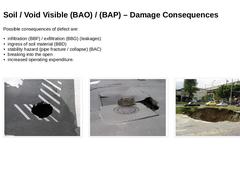
|
Possible consequences of defect are: -
infiltration (BBF) / exfiltration (BBG) (leakages)
-
ingress of soil material (BBD)
-
stability hazard (pipe fracture / collapse) (BAC)
-
breaking into the open
-
increased operating expenditure.
(Image: Road collapse due to damaged sewer pipe) (Image: Road collapse due to a damaged sewer) (Image: Road collapse du to a damaged sewer in South America) |
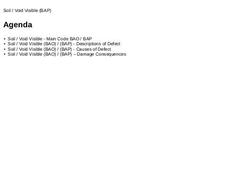
|
|
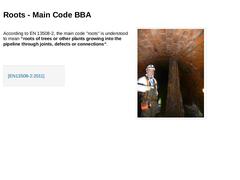
|
According to EN 13508-2, the main code "roots" is understood to mean “roots of trees or other plants growing into the pipeline through joints, defects or connections“. (Image: Root ingrowth in a masonry sewer) |
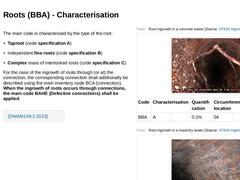
|
The main code is characterised by the type of the root: -
Taproot (code specification A)
-
Independent fine roots (code specification B)
-
Complex mass of interlocked roots (code specification C)
For the case of the ingrowth of roots through (or at) the connection, the corresponding connection shall additionally be described using the main inventory code BCA (connection). When the ingrowth of roots occurs through connections, the main code BAHE (Defective … |
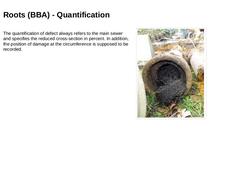
|
The quantification of defect always refers to the main sewer and specifies the reduced cross-section in percent. In addition, the position of damage at the circumference is supposed to be recorded. (Image: Roots (BBA) - Complex root system (C), Quantification 100 % (100 % reduction of the cross-section)) |
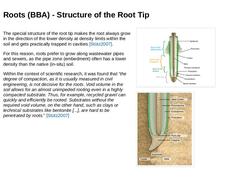
|
The special structure of the root tip makes the root always grow in the direction of the lower density at density limits within the soil and gets practically trapped in cavities [Stütz2007]. For this reason, roots prefer to grow along wastewater pipes and sewers, as the pipe zone (embedment) often has a lower density than the native (in-situ) soil. Within the context of scientific research, it was found that “the degree of compaction, as it is usually … |
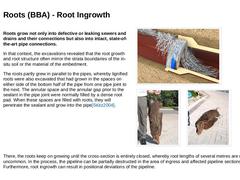
|
Roots grow not only into defective or leaking sewers and drains and their connections but also into intact, state-of-the-art pipe connections. In that context, the excavations revealed that the root growth and root structure often mirror the strata boundaries of the in-situ soil or the material of the embedment. The roots partly grew in parallel to the pipes, whereby lignified roots were also excavated that had grown in the spaces on either side of … |
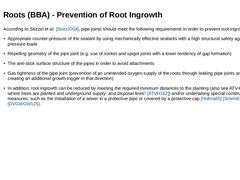
|
According to Stützel et al. [Stütz2004], pipe joints should meet the following requirements in order to prevent root ingrowth: -
Appropriate counter-pressure of the sealant by using mechanically effective sealants with a high structural safety against external pressure loads
-
Repelling geometry of the pipe joint (e.g. use of socket and spigot joints with a lower tendency of gap formation)
-
The anti-stick surface structure of the pipes in order to avoid …
|